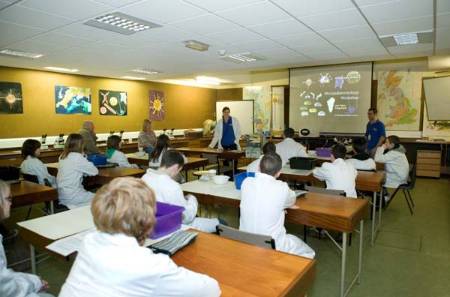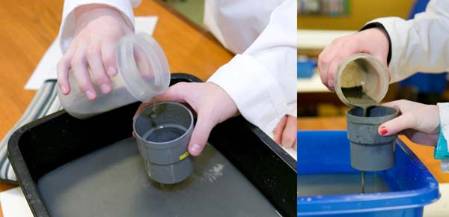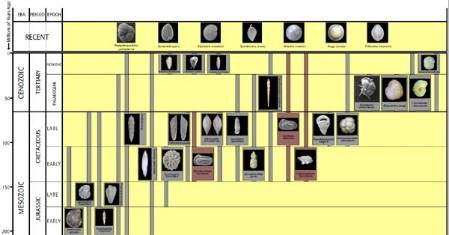The Museum has been running an inspiring schools activity under the "How Science Works" strand of the National Curriculum, in which children carry out their own microfossil research project. In just over an hour, they investigate the microfossils in some Gault Clay collected from Folkestone, and learn the processes behind research including how scientists collect data, use it to solve problems and publish their findings.
Feedback from the school groups shows that it is a fun and engaging way to learn about science away from the normal classroom environment. After completing the exercise, many children indicated that they were more enthusiastic towards a career in science and some even felt that they were already scientists!
 Sally Collins and Jamie Robinson about to start a "How Science Works" session with a school group at the Museum.
Sally Collins and Jamie Robinson about to start a "How Science Works" session with a school group at the Museum.
The activity was developed by Sally Collins, currently part of the Museum Content Development Team, and Dr Craig Koch, while he was studying for his PhD in the Palaeontology Department. It can now be run entirely by Museum educators, while the use of commonly available kit such as washing up bowls and plastic screw topped bottles means that there is potential for holding this schools exercise in locations away from the Museum.
The 'How Science Works' activity
Before the exercise, Gault Clay from Folkestone is crushed into 1-2cm lumps while still wet, and subsequently left to dry. At the start of the class, approximately 100g is then placed in a plastic screw-topped container and boiling water added. After the container has cooled down a bit and some cold water added to bring it down to a safe temperature, it is shaken rather like a cocktail shaker.
While the sediment is soaking, there is time for the class leader to explain the exercise and how micropalaeontology is used in earth science research. A video is shown, featuring Craig and his supervisor Dr Jeremy Young on a research cruise and working in the laboratories at the Museum.
Sieving sediment in the classroom.
After soaking for 15 minutes, the sediment is sieved, dried in a microwave and rehydrated before a final sieving and drying. The microwave heating and subsequent drying ensures that the process can be carried out in a short period of time.
The small microfossil residues produced are then examined under a microscope by the children and a chart is provided to help them identify the microfossils present. By analysing the geological ranges of all the species present, it is quickly possible for the children to determine the age of the clay.
This is similar to the work that a micropalaeontologist might carry out on a well site, where age information could be used by the drillers to decide to continue drilling or stop. Drilling a well too deep can be a costly mistake so sometimes the micropalaeontologist on a well site is put in a major decision-making position!
The chart used by the students to identify their microfossils and decide on the age of the clay.
There is still time for a final class discussion of the results obtained by each group and how scientists communicate their findings by publishing their data. The session I attended recently ended with a very entertaining discussion amongst the children about how the 'peer review process' effectively makes sure that scientists' results are checked before they are published.
Teacher and student feedback
Some of the school class teachers have provided feedback, including:
'Perfectly engaging, challenging and inspiring
'The students were pretty curious and asked a lot of questions which in my opinion shows that the workshop had a stimulating effect on them.'
Children taking the exercise have also had the chance to feedback. Here is a selection of answers given when participants were asked if taking the class had affected their plans for taking science:
'I was thinking about studying science for A-level beforehand - my visit today has reinforced that'
'Yes makes me want to study science more'
Yes, I’d love to do something related to micropalaeontology'
Yes because now I am thinking of becoming a scientist'
Yes, I will go home and purchase a microscope!'
'I will take my science lessons more seriously'
'No it has improved my desire to study science more. I am inspired.'
The foraminifera Epistomena spinulifera; one of the age indicative species of microfossils in the clay.
When the children were asked to say what they 'didn’t know or never realised' some answers were:
I never realised that ...
‘you could have so much fun with clay’
'there were microfossils in clay'
'I do actually like biology'
'that rocks could be dated!'
'science facts had to go through a long process before getting published'
Finally some general comments that I think sum up the impact of the exercise nicely:
'We got to do our own experiment and discover things and come to a conclusion which made us feel like scientists'
[I enjoyed it very much] 'because it was really fun and I learnt more than I probably would in a normal science lesson'
'I enjoyed looking at the fossils from millions of years back and it makes me feel special to realise that I am the first one to see them'
[I enjoyed it very much] 'because we could be scientists and actually find the results on our own. Rather than a classroom where you are told what happens and told the results.'
This positive feedback from previous "How Science Works" schools vists shows that it is a very successful format for learning. Unfortunately it is not currently being run by the Museum due to lack of bookings and staff resource issues. Sally Collins reports that 'we could only run it for half a class at a time due to the space limitations of the Earth Science Teaching Room and the need for everyone to be able to access sinks and electricity. The trend in the past couple of years has been for secondary schools to bring larger and larger groups.'
The exercise has been modified to use washing up bowls instead of sinks and the use of microscopes in other spaces in the Museum such as the Earth Lab mean that larger groups could be accomodated in the future.
The Gault Clay exercise is currently being run successfully at Peterborough Museum. My colleague Dr Steve Stukins has been working with Peterborough and the Natural History Museum's Real World Science Officer Hannah Pritchard to develop a similar hands-on activity using local Oxford Clay. I look forward to hearing about the Oxford Clay exercise and hope to see the successful Gault Clay schools activity running again at the Museum soon.






